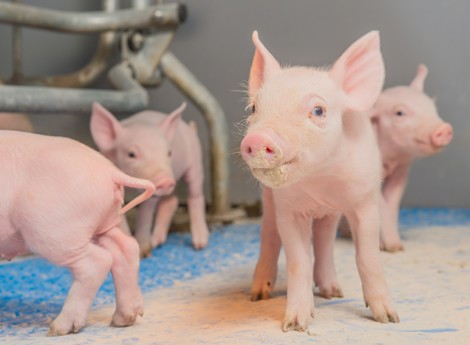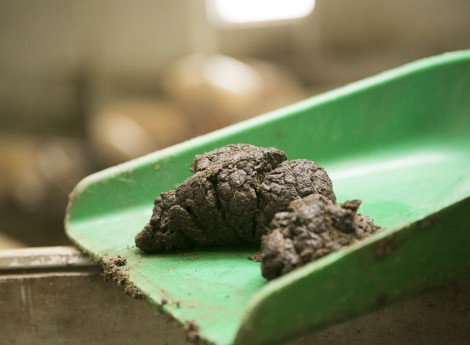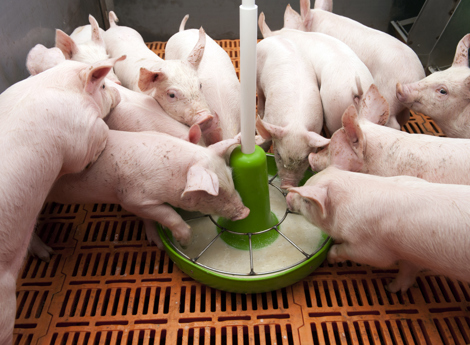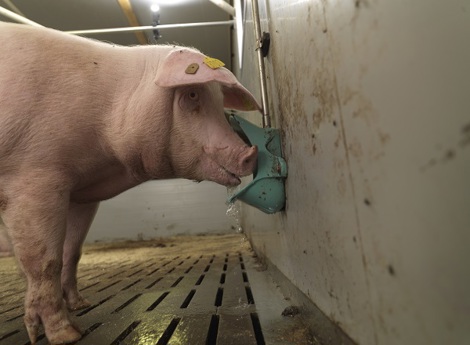
Organisation
The Danish Pig Research Centre (VSP), the umbrella organisation for the entire sector, is domiciled in Copenhagen. Approximately 3,000 Danish pig farms are affiliated with this organisation. The VSP is owned by the pig farmers and has a € 15 million annual research budget.
Pig Breeding
DanAvl is the name of the Danish pig breeding system. Since 2010, the breeding goal has focused on feed conversion and less on the number of piglets. The breeding goal for the most part consists of feed conversion (42%), the piglet survival rate on day five (27%) and growth (11%). The assumption here is that a lower birth weight in large litters is not a problem, as long as the piglets take in colostrum within six hours after birth. The chances of survival of the small piglets in that case is simply good. A focus on colostrum intake is more important than birth weight. Practical experience shows that the piglets are becoming increasingly more vital. Between 2010 to the end of 2015, the loss rate before weaning declined by 0.8% to 13.4%.
Health
The backbone of the Danish pig industry is the high level of health and the SPF system designed to keep health up to par and further improve it. A distinction is made between red and blue farms. The red farms are the pure breeding and parent breeding farms. Participation in the SPF programme is mandatory for these farms. The blue farms are the breeding and pig meat farms. Participation in the SPF programme is voluntary for these farms. The status of all red and blue farms can be retrieved at any time and is available at www.spfsus.dk. This means that a pigmeat farmer knows exactly what kind of piglet he is purchasing.
'A focus on colostrum intake is more important than birth weight'
In Denmark, many piglets on breeding farms are vaccinated against Mycoplasma and Circo. Generally because the buyer (in Denmark or abroad) demands it. The transparent SPF system and the higher delivery weight of 30 kilograms are very valuable for the effective export of Danish piglets and yield added value.
Management of Sow Farms
Two highly productive sow farms were visited during the study trip. A tight structure (weekly plan) and a monitoring system were present on both farms to motivate, stimulate and involve personnel in the business.
'The use of clean grains is standard'
On both farms the number of live births was more than 17 piglets with 1.2 to 1.5 stillborn piglets. In Denmark the use of motherless piglet raising is not permitted and farms consequently work with an average of 20% foster sows.
In contrast to the Netherlands, the sows are not washed in the farrowing room. However, a great deal of attention is devoted to cleaning, degreasing and disinfecting followed by spraying chalk in the farrowing room. The emphasis is on the fact that the sow must always be placed in a dry farrowing room.
What is striking is that everywhere there is a place for the piglets to crawl under and that the farrowing room temperature is stepped down from 23 degrees to 18 degrees. As a result the sow's feed intake is higher and sows leave the farrowing room in good condition.
Sow Nutrition - Key Elements
During our trip we extensively reflected on the nutrition of highly productive Danish sows. The following things stood out:
- Clean Grains: The use of clean grains is standard in Denmark, whereby the grains are blown clean, as well as sieved. We have been doing this ourselves for our piglet feeds for the past two years and since last year for our raising and premium sow feeds.
- Additional Fibre: In order to lower the number of stillborn piglets in Denmark, currently a lot of attention is paid on using additional fibre in sow feeds and manually providing a 'kwix mixture' that contains multiple crude fibre-rich raw materials, prior to farrowing.
- Acidified Water: On one of the Danish research farms the number of stillborn piglets was lowered by providing lactating sows with acidified water via the liquid feed installation, each time after the sow was fed liquid feed. This has since become a standard in spite of the fact that an additional drinking nipple is now present in the trough.
If you are interested in the full presentation and in gaining an impression of the study trip's atmosphere, do not hesitate to contact us.
If you want to learn more about this topic, please contact your local De Heus' specialist




